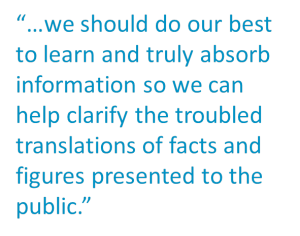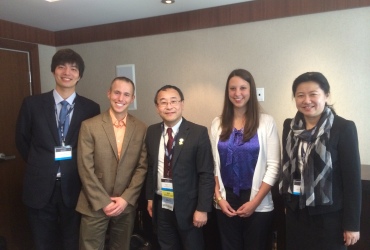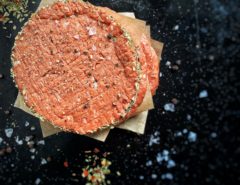Often friends and family sigh to me– their convenient “foodie friend”– asking for advice on diet foods or about what those scary industrial manufacturers put into them. I have heard many requests for my opinion, but have decided, as politely as possible, to not answer their questions anymore. This is mostly because I am never sure I can give them the correct answer, or at least an answer they will be happy with.
As a young food scientist in training I am aware of the conflicts and opinions regarding several hot and current food industry topics. When I drink coffee and tea sweetened with artificial sweeteners—am I going to self-destruct some day? Should I be eating organic? What about going on the paleo diet? What is the paleo diet? Are preservatives unhealthy? What’s natural? But even as a student surrounded by resources differentiating food fact from fiction, I, and I believe many of my colleagues, find it hard to have all the answers. I think it might be because there are so many trends in the food market right now no one (including myself) knows where to begin.
Often on visits with friends of minimal food science backgrounds I hear concerning conversation starters, which consequently make my blood boil. Do they not realize this is what I am working to become– the mad scientist eager to bring that tutti, fruity flavor to their favorite, zero calorie beverage? It can hurt when my friends tell me that all additives are bad or when they voice that they’re vehemently against preservatives and then ask me why their arugula is spoiling in one day.
I get even more frustrated as I witness friends refusing artificial sweeteners added to their morning coffee but insist on zero-calorie, diet beverages. And when they chose to eat gluten free and then drink wheat beers all night long.
I begin to feel resented, not to mention ostracized, during every friendly get together that turns into a roast of Alex’s chosen life path.

Source: gifsec.com
This is not a self-deprecating diary entry (although reminiscent at times I suppose); it is more about the speed of food science and technology and why this is helping and hurting both food scientists and consumers alike. Yeah. No contradictions here. Right.
Food science and technology is blossoming and creating more efficient, effective and unique processes for new products, while also improving old processes or products. Innovation has affected the grocery store aisles, especially recently. For example, Nabisco has created various line extensions that were previously not on anyone’s radar–BIRTHDAY CAKE OREOS. Hallelujah! In addition, my new favorite yogurt flavor is caramel macchiato. Ah…finally the best of both worlds. I love drinking coffee, but now I can eat it too. We can’t forget fresh bags of lettuce that last more than a day in our refrigerators either. And please do not forget to check out the new ‘flavor your own icing’ creations. As a child, tween, adolescent, and “adult,” this is my jam.
But what if these technologies, some new and some relics of food science, really are bad for us in the long term, as many seem to think? It’s hard to find reliable research on either side of this raging debate! There are certainly many consumers refusing to buy into these new trends because “our ancestors didn’t eat it”—so why do we need it? Well, we technically don’t need it. But we as consumers do want it; this aspect of innovation is what makes eating such a culturally entertaining event. Eating is not just nourishing, it’s fun.
Conflicts also arise when discussing new and innovative processing. One technique that seems to be drawing more attention lately is high pressure processing. The process is gaining popularity due to its dual benefit: safety while retaining desirable sensory aspects. Your snozberries will taste like snozberries! And look like them, too!
BUT, with a new process also comes the back lash. For example, this emerging processing system already has a lawsuit in the works from early this year, according to a story on FoodNavigator. A new juice company utilizing this process may be in trouble for labeling their juice as “fresh.” What descriptions can you use on a food label that’s been through high pressure processing? Well you mustn’t say “fresh” but “raw” is okay. Does this make sense? No wonder consumers (as well as myself) are confused. I am getting more confused while writing this.

Ultimately, it seems like advances in food science create more questions than answers, but this perpetual state of bamboozlement is what moves research forward. We will learn, but perhaps too slow for consumers and scientists to have all of our and their questions answered. With innovation comes more questions and potential complications. Maybe there is a problem with the industry implementing ideas too quickly to understand the long term effects, and if so, maybe consumers with their ever changing and “always right” opinions are not to blame for all the controversy. If there is anyone to really blame at all. It might be that the public needs more support and education about what researchers are still trying to understand themselves, among a clarification of the facts.
Consumers will never not have opinions on the latest trends and we will never be able to solve all the problems of our hard-headed best friends that know they don’t and won’t eat something. However, I think as students and teachers we should do our best to learn and truly absorb information so we can help clarify the troubled translations of facts and figures presented to the public. I not only want to have strawberry shortcake, but I want to eat this cake without my friends spouting opinions on the artificial strawberry syrup supposedly making our insides implode.
It’s important to learn the facts, admit when research is still inconclusive and keep our chins up. We can calmly engage in conversations–and at the end of the day– have our cake and eat it too.
Alex Pierce is a graduate student in the Food Science and Technology Program at The Ohio State University. Her research interests include sensory and psychophysics, in particular the differences between orthonasal and retronasal aroma perception and their neural and physiological basis, as well as their potential benefit on cognitive functions.
Cover image credit: blogspot.com





This is great.